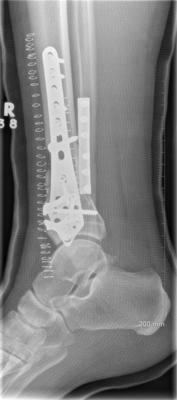Slowly Healing
- Details
- Written by Kevin Horton
- Hits: 2996
Things are going well, all-in-all. I’m not having any pain, as long as I am careful to move the left arm slowly. If I move it too quickly, the healing collarbone lets me know about it. I’ve got no pain in the broken right leg or left wrist. I’m a bit more mobile every day. Terry’s back injury appears to be healing well, and at the moment it looks like she may avoid back surgery. I’ve got another follow-up visit with the othopaedic surgeon coming up on Thursday.
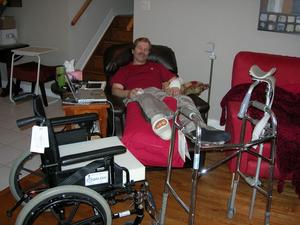 The house is full of rented medical equipment. I can’t climb the steps to the bedroom, so I’m sleeping in a rented hospital bed in the dining room. I’ve got a low wheelchair so I can move around the main floor of the house, using my right hand to turn the right wheel, and pulling with my left foot on the floor to move the left side of the wheelchair. Fortunately we have an open concept main floor, with 100% tile or hardwood flooring, so I can roll around without difficulty.
The house is full of rented medical equipment. I can’t climb the steps to the bedroom, so I’m sleeping in a rented hospital bed in the dining room. I’ve got a low wheelchair so I can move around the main floor of the house, using my right hand to turn the right wheel, and pulling with my left foot on the floor to move the left side of the wheelchair. Fortunately we have an open concept main floor, with 100% tile or hardwood flooring, so I can roll around without difficulty.
The circulation and lymphatic system to my right foot was a bit disrupted by the injury, and I’m not putting any weight on the right leg (weight on and off the legs activate the “pumps” in the lymphatic system), so I need to keep my right leg fairly high or the foot starts to swell. I’m spending most of my time in an electric reclining chair instead of the wheelchair. I’ve got a special walker that I use to help me transfer from recliner to wheelchair, wheelchair to bed, etc. It has a padded horizontal trough that I put my left elbow in, so I can hop on my left leg.
A significant percentage of my time is spent filling out never-ending insurance forms, or dealing with other fallout from the accident. I spend a few hours on the weekdays doing work-from-home (e-mail,reviewing documents, etc). I’ve also started working on several articles that will hopefully eventually end up in Kitplanes magazine.
Terry’s sister Sue is still here - she is about half way through her three week stay. After she leaves, two more of Terry’s sisters will come for a week each. Terry’s coworkers have brought by several loads of home-cooked food, and Hugh, one of my coworkers, gave us a bunch of his world famous home-made spaghetti sauce. Jim, another coworker, has spent untold hours helping out in myriad ways. Thanks everybody! I don’t know how we would have made it without the help of friends and family.
Thank you to everyone who has e-mailed or phoned. Your support means a lot to Terry and I. We’ve had many offers of help, and we will cash some of those in soon, as there is some yard work that will need doing.
Initial MT vs Hartzell Cruise Data
- Details
- Written by Kevin Horton
- Hits: 5276
I gathered some cruise performance data on three flights with the Hartzell prop (the older model, with 7666A blades, not the newer “blended airfoil” prop), before it met its demise, and I was looking forward to getting a comparison with the new MT prop. All the cruise data with the Hartzell prop had been gathered when the EFIS was working, and I recorded EFIS and engine monitor data on my laptop, for later analysis. I used an experimental method to determine engine power, based on fuel flow data. This method was apparently developed by Lycoming, as a means to determine engine power during flight testing. It supposedly allows engine power to be determined, based on fuel flow, fuel flow at peak EGT, rpm, compression ratio and engine displacement. I consider the method as experimental, so I won’t share it with the world yet. If it proves to give credible and consistent engine power, I will document it and provide a spreadsheet that incorporates it.
My first attempts at gathering speed vs power data were on flights 6 and 7, and the results showed a lot of scatter. Close analysis of the data showed that I needed to adjust the fuel flow much more slowly when searching for the fuel flow at peak EGT, and that I needed longer stabilisation times to better determine airspeed at each power setting. On flight 10, I was much more successful, using very slow fuel flow variations to determine fuel flow at peak EGT, and averaging the speed for 10 or more minutes at each power setting. The data from that flight shows a very smooth variation of speed vs power. But, there is usually some small vertical motion in the air mass, which affects aircraft performance. The air in a low pressure system is rising, and the air in a high pressure system is descending. So, it is best to rather performance data from several flights, in different weather systems, and average the results.
I installed the MT prop, model MTV-12-B-C/C183-59b, in February, but the EFIS has not worked properly yet in 2009. Thus I have been unable to record any EFIS data, and the performance testing with the MT prop has relied on hand recorded data from the round dial ASI. Based on the propeller efficiency data claimed by Hartzell and MT, I had hoped that the aircraft would be several knots faster with this new prop. However, the speed vs power data I recorded on flight 18 appears to suggest that the aircraft is no faster than before, and in fact may be slower by a few knots. :( But, the only data I have with the MT prop is not of the best quality, so this conclusion may change when I get more data.
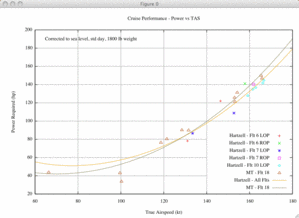 This plot shows all the cruise performance data I have taken, with both Hartzell and MT props, with each test point corrected to sea level standard day and 1800 lb weight. You will note quite a bit of noise in the data. The data for flight 10 with the Hartzell prop is the best quality, and it shows several knots more speed than the other Hartzell points. I’m not sure if the higher speed is truly correct, or whether there was some vertical air motion on that day. The data for the MT prop shows a lot of scatter, due in large part to the fact that it was hand recorded, rather than averaging several minutes of cruise flight as I did on flight 10 with the Hartzell.
This plot shows all the cruise performance data I have taken, with both Hartzell and MT props, with each test point corrected to sea level standard day and 1800 lb weight. You will note quite a bit of noise in the data. The data for flight 10 with the Hartzell prop is the best quality, and it shows several knots more speed than the other Hartzell points. I’m not sure if the higher speed is truly correct, or whether there was some vertical air motion on that day. The data for the MT prop shows a lot of scatter, due in large part to the fact that it was hand recorded, rather than averaging several minutes of cruise flight as I did on flight 10 with the Hartzell.
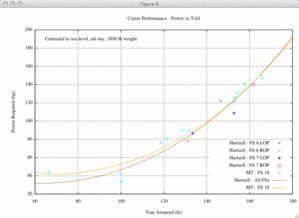 This plot is similar to the first, but it does not include the Hartzell data from flight 10. On this plot, the average of the MT data is very close to the average of the Hartzell data.
This plot is similar to the first, but it does not include the Hartzell data from flight 10. On this plot, the average of the MT data is very close to the average of the Hartzell data.
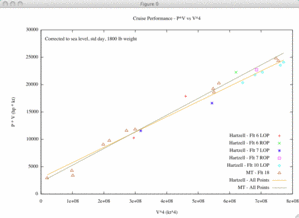 This plot shows power times speed vs speed to the fourth power. In theory, the points for each prop should approximately fall on a straight line. You can see that the points for flight 10 make a nice straight line. The other points show a fair bit of scatter.
This plot shows power times speed vs speed to the fourth power. In theory, the points for each prop should approximately fall on a straight line. You can see that the points for flight 10 make a nice straight line. The other points show a fair bit of scatter.
The EFIS was sent to Dynon for service, and returned home a few days ago. Whenever I start to fly again, I will be able to get much better quality data with the MT prop.
Screws, screws and more screws
- Details
- Written by Kevin Horton
- Hits: 3031
I had a follow up appointment with the orthopaedic surgeons on Thursday. New X-rays were taken, and the cast was removed so the incisions could be inspected and the staples removed. The incisions seem to be healing well, but there is one small tender area right on the bump on the inside of my right ankle that will bear some watching.
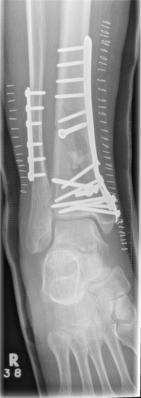 I was able to get copies of the latest X-rays. There is an impressive bunch of hardware in there - I count 19 screws. I’m sure my coworkers will quickly learn not to be behind me in airport security.
I was able to get copies of the latest X-rays. There is an impressive bunch of hardware in there - I count 19 screws. I’m sure my coworkers will quickly learn not to be behind me in airport security.
Car Accident - Another Long Pause
- Details
- Written by Kevin Horton
- Hits: 5543
The forced timeouts on my RV-8 project are getting quite frustrating. First, I lost four months due to the big engine/prop overspeed. Then, I was on the road a lot. And now, there will be another big pause of four months or so as I recover from injuries sustained in a nasty car accident. Frak.
Just after 4 AM on Sunday, 15 Mar, I was driving Terry to the airport to catch a flight so she could go on a Caribbean cruise with friends. I was planning on spending several days of the week she would be gone at the airport, and hoped to bite off a big chunk of the flight test program. It was not to be.
We were driving north on Albion Road, in an area with a speed limit of 80 km/h (50 mph). Suddenly Terry yelled that she thought the on-coming car was in our lane. I focussed on that vehicle, now about 200 ft away (less than 2 seconds), and it was in our lane and seemed to be continuing to move to our right (his left). Continuing straight ahead wasn’t a good idea, and it looked like a swerve into the ditch to the right would be a turn towards the other car’s path, so I made a instant decision to swerve to the left.
It looked like we might get by him for a moment, but just before we crossed he swerved sharply back towards us and we hit. I don’t recall braking, but the severe injuries to my lower right leg suggest I was probably standing hard on the brakes when we collided. Our car came to rest upright, on the left shoulder, facing 180 deg from our original direction. Terry and I were conscious, but I could feel that something was wrong with my right ankle. Terry was complaining about a sore back. A small fire started immediately in the engine compartment, so we knew we had to try to get out of the car. Fortunately, we were both able to open the doors, exit the car, and crawl along the shoulder behind the car. My cell phone was inexplicably inop (the little green “Go” button was dead), but Terry did a bang-up job calling 911 on her cell. An off-duty paramedic stopped and helped Terry and I get a bit further from the car, which was really burning by now, then he went to help the guy from the other car who had much more severe injuries than we did (he was apparently not wearing his seat belt).
A fire truck, paramedics, police car and ambulances showed up fairly quickly, and Terry and I were rushed off to hospital. Initially we were side-by-side in the emergency department, but we eventually got split up after they realized she should be transferred to another hospital that had a special unit to handle back injuries.
Terry has a compressed vertebrae, and may yet require back surgery. She is wearing a back brace whenever she isn’t flat on her back, and wouldn’t look out of place as a modern super hero. She was released from hospital on the 18th, into the car of my sister, an MD who had flown out from Nova Scotia for a week to help out. She will hand over to one of Terry’s sisters, a surgical tech, who arrives today for three weeks. Thanks Nat and Sue! Some very comprehensive attendant care assistance paid for by the other driver’s car insurance will be in place before Sue leaves.
I got home yesterday evening, after 8.5 days in hospital. I was extremely impressed by all the staff at the Ottawa General Hospital. Everyone from the cleaning lady who stopped her Mach 9 room cleaning one day to help me reach my breakfast, to the two orthopaedic surgery residents who short-circuited normal protocol by grabbing my hospital bed late on day one, and pushed this big Behemoth of a bed down some back hallways into a back door of a CAT scan room, so they could jump the CAT scan queue in an attempt to get the info they needed to get me into surgery that evening. Their valiant attempt failed, as each new piece of evidence raised more questions that required more tests or imagery. I finally hit the operating room in the afternoon of day three (Wednesday the 17th). The surgeons, nurses, orderlies, porters, etc were all outstanding. Thanks to you all for your help and compassion.
I’ve got a broken left wrist, broken left collarbone, and a very badly broken right tibia and fibula (the two bones in the lower leg). The bones in the lower right leg were broken in eight large pieces and a multitude of smaller pieces, and now have two plates and 17 or 18 screws holding them all together. Word to the wise - don’t get in line behind me at the airport metal detector :)
The doc says no weight on the right leg for three months then it’ll be an unknown number of weeks of physio before I’ll be flying again. My plans to fly the RV-8 to OSH this year are shot. When I think I’m ready to fly again, I’ll do a session in Transport Canada’s C550 simulator to see if I have the strength, range of motion, and fine control needed for all normal, abnormal and emergency procedures. If that feels good, once I get my medical paperwork back, I’ll do some flights on tricycle-geared aircraft before I try a taxi test in the RV-8. If low and medium speed taxi feel OK, I’ll start flying again.
You wouldn’t have to change much to have had either Terry and/or I be unable to get out of the car, and we would have been in a raging inferno. A friend went to see the car to attempt to salvage a few things, and he found nothing left but metal and ashes in the passenger compartment. We are very lucky to be alive, and that our injuries will all heal.
The original Ottawa Citizen story seems to say that someone else pulled Terry and I from the car. Note quite true - we got out under our own power. The later story at least gets that part correct.
Flight 19 Report
- Details
- Written by Kevin Horton
- Hits: 4521
Inter-flight activities:
- Removed EFIS and shipped it back to Dynon. Plugged the pitot and static lines that normally connected to the EFIS, and did a static system leak check.
- Took turn and bank indicator to First Air, to have them determine whether it can be repaired, or whether I need to buy a new one.
- Checked and adjusted pitch trim speed. The trim speed governor had been set so that 30 seconds were required for the trim to run full travel. This was changed to 23 seconds, which appears to the be the fastest speed that can be set by the trim speed governor.
Events:
- Transponder check with Ottawa Terminal. They reported continuous tracking of my return, and a good ident. Their reported altitude was about 200 ft lower than the actual baro altitude. However, the altitude encoder accuracy was checked to be well within limits prior to first flight last year.
- GPS ground and flight tests in accordance FAA Advisory Circular AC20-138A, Airworthiness Approval of Global Navigation Satellite System (GNSS) Equipment, which is the same guidance material as is used for IFR GPS certification tests on type-certificated aircraft. All ground and flight tests passed.
- COM 2 reception checks at all azimuths. COM 2 is a Microair 760, connected to an Sportcraft antenna (designed by Bob Archer), mounted inside the left wing tip (order from Chief Aircraft). Reception of the CYTR ATIS was checked at 75 nm range. The reception was good at all azimuths, except for a very narrow range of angles around the 3 o'clock position where the reception was much weaker, but still readable. I do not understand how the radio energy gets to the antenna from the 3 o'clock azimuth, as the fuselage and wing would both seem to be between the ground station and the antenna. But it works. Magic.
- COM 2 transmission checks at all azimuths. CYND radio reported good reception at 45 nm range, even if they were at the 3 o'clock position. They did not respond to any calls made at 75 nm, on all azimuths, at 8500 ft, so it appears the effective transmission range is somewhere between 45 and 75 nm.
- NAV 1 and NAV 2 range checks. Both NAV 1 (GNS 430) and NAV 2 (Narco 122D) picked up the YCF VOR at 75 nm range. The reported VOR radials corresponded to the bearing to the station reported by the GPS. Both NAV receivers are fed from a Sportcraft (Bob Archer design) antenna hidden inside the right wing tip (pictures on Sam Buchanan's web site).
- Two touch and go landings, one with zero flap, using a 75 kt approach speed. The landings are starting to be more predictable, with much less tendency to bounce, and less directional workload during the rollout.
New Snags:
- It was extremely cold at altitude, and there was a significant draft coming from somewhere, perhaps from the aft canopy skirt area. I was wishing I had worn my insulated pants, and boots. I need to experiment with weather striping around the aft canopy skirt.
- Some right rudder force is required in cruise. This isn't a new snag, but I had forgotten to record it until now. A wedge must be added to the left side of the rudder trailing edge.
- The link at the aft end of the L tailwheel chain keeps flipping 180 degrees during flight, so what should be the front end is at the back. This does not cause any handling problems, but it puts the link in an orientation that puts much more stress on it, as it doesn't fit through the hole in the tailwheel control arm this way, and thus it sits at an angle. The link on the R side, never does this, even though there is no obvious mechanical difference between the two sides. Further investigation is required.
Existing Snags:
- RPM still low in level flight with max rpm selected. An e-mail was sent to Aero Technologies support asking for advice.
- EFIS does not power up. It is in a continual reboot cycle at about 1 Hz. Thus no EFIS data is recorded. The EFIS was sent back to Dynon for service.
- SD-8 Alternator does not seem to be working. Will defer troubleshooting until engine break-in is completed, as it would be useful to check for AC output from alternator during an engine ground run.
- Loud buzz at high speed from aft part of canopy skirt. Try some stick-on Velcro or felt.
- Turn needle in turn and bank not working. The OFF flag is removed when power is applied, so power is getting to the instrument. The instrument was sent to First Air for service.
- Pitch trim speed of movement is slow during a touch and go.
Notes:
- None
Results of Data Review:
- The laptop computer failed to record engine monitor data on this flight. Further investigation is required.
Aerobatics Approval and Exemption to Controlled Airspace Restrictions
- Details
- Written by Kevin Horton
- Hits: 5173
I am publishing the following info on an exemption to the Canadian Aviation Regulations (CARs) rules on aerobatics, to help me (and other people), find this info in the future.
CAR 602.27 has a very strict requirement which pretty much prohibits aerobatics in most of Canadian airspace.
602.27 No person operating an aircraft shall conduct aerobatic manoeuvres
- over a built-up area or an open-air assembly of persons;
- in controlled airspace, except in accordance with a special flight operations certificate issued pursuant to section 603.67;
- when flight visibility is less than three miles; or
- below 2,000 feet AGL, except in accordance with a special flight operations certificate issued pursuant to section 603.02 or 603.67.
The problem is that most airspace in southern Canada above 2000 ft AGL is controlled airspace, and you pretty much need to be an airshow pilot or aerobatic competitor to get issued a special flight operations certificate under CAR 603.67. I dug into this apparent problem with a contact in that part of Transport Canada, and he told me that they were aware of the problem, and that they had issued an exemption to this reg to sort out the problem.
Basically, CAR 602.27 (b) is replaced with:
- The person shall advise the appropriate air traffic services unit prior to conducting aerobatic manoeuvres in any class of controlled airspace that requires radio contact with air traffic services;
- Where the aerobatic manoeuvres will be conducted in Class A, B or C airspace or Class D Control Zones, prior coordination between the person conducting the aerobatic manoeuvres and the air traffic control unit providing air traffic control services in the above airspace shall be carried out.
Of course, I can’t legally fly aerobatics yet, as I need to go through an approval process with Transport Canada before I can legally fly aerobatics in this aircraft. I still need to work through how to unravel a Catch 22 - at the moment, I am required to have a placard on the instrument panel “Aerobatics Prohibited”. I am required to comply with all placards. I can’t remove that placard until I get approval, and in order to get that approval I must evaluate the aircraft by performing aerobatics.
